Why hay?
Someone asked me this last week, “Why do you hay?”
To feed our sheep. For the majority of farmers in the north country, haying feeds dairy and beef livestock, particularly through the winter. But, there’s another reason: to keep agricultural land agricultural. Lots of people care about “local” food these days. Local food takes land. Think about what it took to clear and maintain those hay fields and croplands over the years. I hate seeing hay fields growing back up to brush just as I hate seeing old barns caving in.
I’ve spent some part of most every summer for the past 40 years “making hay.” I’ve done loose hay, much as my Amish neighbors still handle hay, raking cut grass into windrows, then using a hand hay fork to create hay cocks (read this excerpt from “The Book of the Farm” by Henry Stephens for more on low-tech hay-making). Hay cocks, or windrows run through a hayloader, are loaded onto a flat hay wagon and then, ideally, lifted by a pulley-operated hay fork running along the ceiling of the hay mow (pronounced to rhyme with cow) and placed in the mow for storage, wagon-load by wagon-load. (By mid-winter, a sharp hay knife, like a machete, is needed to cut chunks of hay out to feed animals.) We never had an operational hay lifter, so lots of handling from field to barn.
Here’s what it looks like for us nowadays.

Bill and our friend David doing what every farmer has to do: field repairs to equipment. Here, the baler threw a chain. Pierre observes. I wait for the farmer mechanic to get things up and running again so I can continue to bale.
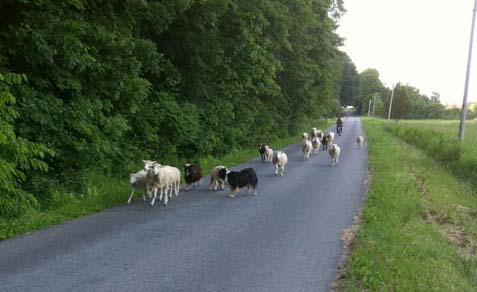
Here's who eats the hay. A group of our sheep heading home to the barn. Pierre's bringing up the rear on his bike; Leda is trying to act like a Border Collie (sometimes yes, sometimes no).
Most large farmers round bale their hay, or make “haylage”–chopped hay which can be stored in concrete silos and mixed with other feed. Here’s a neighbor’s place this morning: large trucks will carry away chopped haylage.
Everyone has seen round bales on the landscape. These must be moved with a tractor. They may be stored under cover or wrapped in white plastic to diminish spoilage. Here’s a video of round bales being made…watch the runaway bale, it’s cool.
How do you hay? Or, if you have questions about haying, perhaps some farmers out there will help with answers.
Tags: agriculture, haying





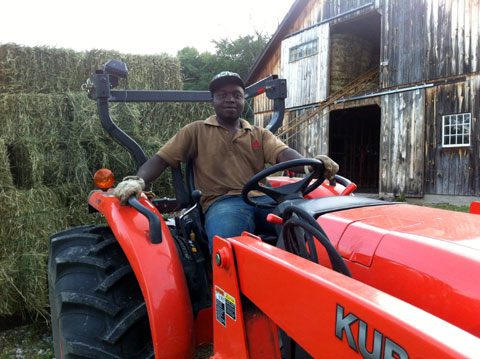
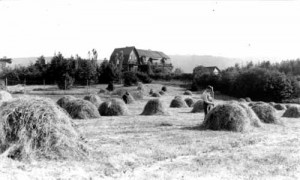
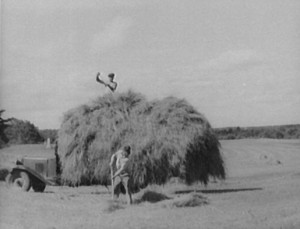

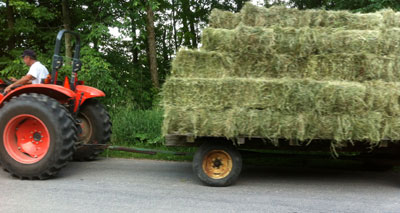
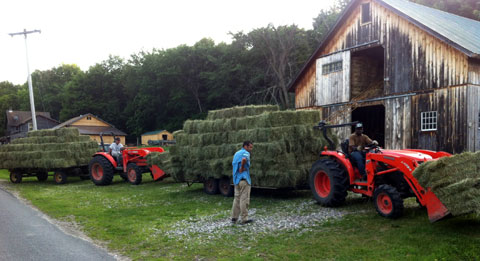
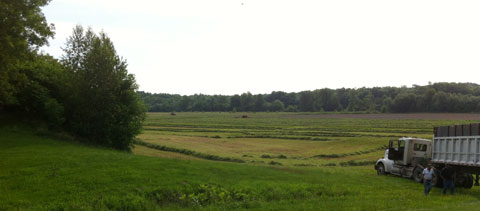



Great story, and I love the photos!
It may sound crazy to some folks, but I love season-driven work. There is a right way, and a right time for most agricultural and forest chores…you can do it some other way, or some other week, but you will have to work harder to accommodate your poor planning or stubbornness. I love the way old, well thought out systems work.
Love these working landscape stories. Thanks, Ellen! I was interested to read that St. Lawrence University Assistant Professor of Biology Susan Willson has been awarded a $2,500 grant by the Northern New York chapter of the Audubon Society for continued study on a project called “Bird-Friendly Hayfields as Refugia for North Country Grassland Birds.”
I wonder what hayfield owners are doing to accommodate nesters. People who grow hay for export as mushroom fodder could hold off on mowing until birds have fledged, but that’s not an option if you must keep it dry for feed.
Great to see farmland being kept as farmland. A while back, I heard landowners around Canton saying that they wanted to keep their land open, but they couldn’t find anyone to cut the hay, even in return for keeping what they cut. Has that changed at all? Are there any more folks interested in haying fields these days?
Mary,
In addition to our fields, we cut hay for neighbors. Our neighbors Phil and MJ are avid birders. So, instead of doing an early cut on their property–which does interfere with nesting and fledging, we use their hayfields as pasture in May and June, then do their fields as “second cut” hay in mid- to late July, allowing those baby birds to clear out. Nonetheless, there is death in any haying operation–if not birds, certainly small ground animals which are flushed out and often snagged by hawks or killed by the cutting bar (look up to see the vultures circling). Agriculture, which feeds us, disturbs some species and helps others (crows and wild turkeys in the corn field, for example).
Ellen B–Very important observation, re: difficulty in maintaining hay fields as hay fields with the decline in number of farmers. The trick, I think (and this is strictly speculation on my part) is to sustain the agricultural land in the near future–until the next generation of farmers steps in. And, I do believe there is a resurgence of interest in farming but there may be lag time between when new farmers take up the plowand the need to maintain land until they do. The demand for hay land has declined–the demand for corn has gone up.
There is still a need for peasants-
strong broad backs
glistening with sweat, dusted with chaff.
They swing from mows, lay underneath the trees
and quaff
not tuscan wine, but water, crusty bread and cheese,
they watch the leaves, and laugh.
A few years ago I did a commentary on haying for NPR- because to me it is one of the quinessential summer activity, that allows kids to be productive, test themselves and prove the miracles of human muscles, ingenuity in fixing things, and camraderie. http://www.npr.org/templates/story/story.php?storyId=5618393